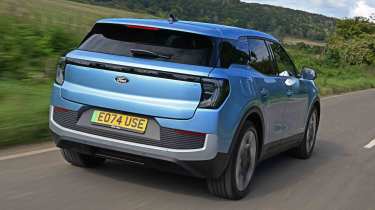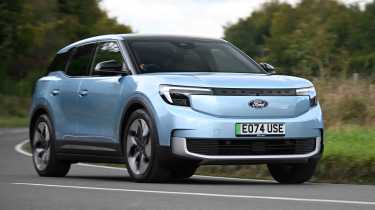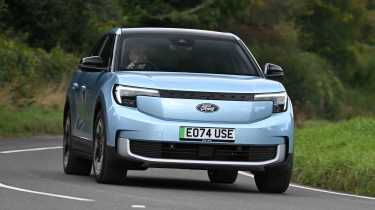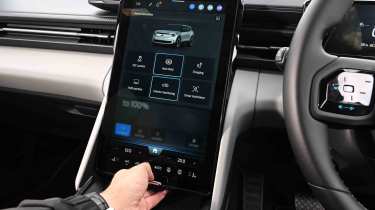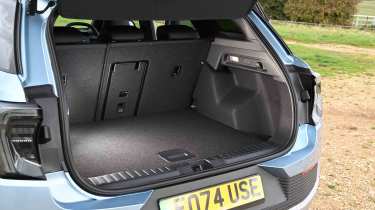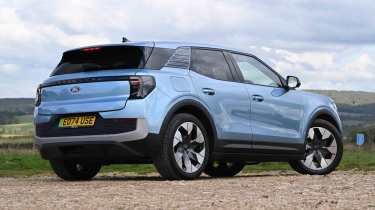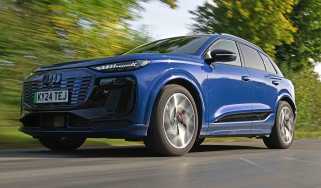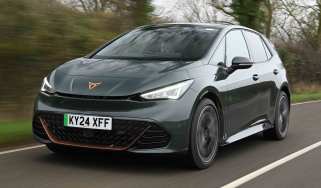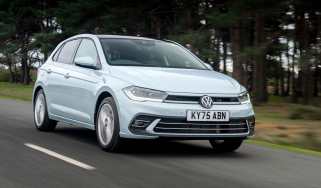Ford Explorer review
The Ford Explorer electric SUV has striking, chunky looks and appeal that’s more than skin deep

Our opinion on the Ford Explorer
Trying to stand out in this busy electric SUV market is no easy task, but the Ford Explorer manages it. The smooth front and rear ends, along with squared-off lines and small windows, all combine to give it a purposeful look.
There’s no real history of Explorer in the UK – the American SUV was more famous for being in Jurassic Park than in regional Ford dealerships – and since this latest all-electric model is another SUV, it’s just a variation on an existing theme. Under the skin of the Explorer is the MEB platform created by the Volkswagen Group and used by Ford to fast-track its expansion into the world of electric vehicles. Overall, we’d say that the Explorer is one of the better models to use the MEB underpinnings – we’d certainly choose one over a Volkswagen ID.4 or Volkswagen ID.5.
About the Ford Explorer
You have to feel a little sorry for the Ford Explorer. This car finds itself as the middle child between the Ford Mustang Mach-E that came before and the Ford Capri that followed soon after. The latter stole quite a bit of attention away from the Explorer by resurrecting the name of an iconic coupe for an electric SUV.
But of these three models that all use names from Ford’s back catalogue, the Explorer is probably the one that will cause the least controversy among Ford fans.
The range is simple, starting with Style before going up to our recommended mid-range Select trim. The top-of-the-range Premium is the only way to get four-wheel drive and adds some extra niceties, but we don’t think it’s worth the additional cost over a Select trim.
We’ve tested multiple variants of the Ford Explorer since it first arrived on the UK’s roads. We even pitted it against the popular Renault Scenic in one of our real-world twin tests, but it didn’t quite manage to defeat its French foe. The Ford did come close, but the Renault’s standard-fit heat pump, bigger boot and lower price gave it the edge.
Ford Explorer prices and latest deals
Performance & driving experience
Pros |
|
Cons |
|
Ford Explorer buyers have a few options to choose from powertrain wise. The Standard Range model is fitted with a 52kWh (usable) battery pack, while the Extended Range variants feature a larger 77kWh unit. The majority of the Explorer line-up is powered by a single rear-mounted electric motor, but opting for the range-topping Premium trim adds the option of a twin-motor, all-wheel drive powertrain. To help make up for the increased power consumption, this setup gets a slightly larger 79kWh battery.
In base Style spec, the Ford Explorer sends 168bhp and 310Nm of torque to its rear wheels. Moving up to the mid-range Select model brings in the larger battery and drastically pumps up the rear motor’s output to 282bhp and 545Nm of torque. The fanciest Premium trim can be fitted with either rear-wheel powertrain, depending on your preference and budget, but it also brings in the all-wheel drive option, which returns 335bhp and 679Nm of torque.
One of the few clues to the Explorer’s VW-derived tech inside is the drive selector. As with other MEB models, there’s a chunky column shifter to the right of the steering wheel, which has D and B drive modes, with the latter offering stronger energy recuperation to help top up the battery when decelerating. There’s no one-pedal setting, but adjusting the throttle in B mode means you’ll only really use the brake pedal when you need to come to a complete stop.
| Model | Power | 0-62mph | Top speed |
| Style Standard Range RWD | 168bhp | 8.7 s | 99mph |
| Select Extended Range RWD | 282bhp | 6.4 s | 112mph |
| Premium Extended Range AWD | 335bhp | 5.3 s | 112mph |
Performance, 0-60mph acceleration and top speed
The 52kWh version of the Ford Explorer has a 0-62mph time of 8.7 seconds and a top speed limited to 99mph. The extra power on tap in the 77kWh RWD cars means they can accelerate from 0-62mph in 6.4 seconds. The Explorer certainly isn’t the fastest electric SUV around, but it’ll still be fast enough for most drivers’ everyday needs.
The more powerful four-wheel-drive models have to carry the extra weight of the 79kWh battery, but the traction and power boosts on offer mean 0-62mph takes 5.3 seconds. All of the big-battery models have a top speed that’s electronically limited to 112mph.
Town driving, visibility and parking
The Ford Explorer features a high-set driver’s seat, so there’s a good view of your surroundings. Visibility is also helped in part by the novel C-pillar windows, which have a graphic on the outside, but are clear when viewed from the inside.
Front and rear parking sensors and a reversing camera are fitted, while light steering and well judged throttle response help with low-speed manoeuvres. From the lights, the Explorer pulls away briskly as power is sent to the rear wheels.
There’s a slightly unsettled ride when the car is fitted with 20-inch wheels – the Select model with 19-inch rims does better in this regard, but not by a huge amount. Another potential pitfall of these large wheels is their vulnerability to kerb damage.
Country road driving and handling
A healthy spread of torque means it’s easy to get up to speed in the Ford, and overtaking is simple, too. Plant your right foot and there’s a pleasant bit of shove on offer, but it’s far less harsh than the organ-rearranging nature of cars like the Tesla Model Y Performance. Unless you’re a massive thrillseeker, the Ford has just enough oomph to put a smile on your face.
There’s a soft edge to the handling, though, which results in some body roll, but the car never feels unstable or wayward, while the steering reacts quickly to inputs without making the SUV feel nervous. A consequence of the Explorer’s fairly soft suspension, though, is that it struggles to settle down on anything other than a perfectly flat surface. While we wouldn’t call it annoying, there’s a frequent bounciness to the ride that’s certainly noticeable, especially on more uneven B-roads.
Overall the Explorer is a more pleasant and enjoyable car to drive than a VW ID.4, although it doesn’t quite capture the same sense of driving fun that other Fords have managed in the past. This can largely be put down to the car’s kerbweight of over two tonnes.
Motorway driving and long-distance comfort
At higher speeds on motorway-grade tarmac, the Explorer settles down to deliver great cruising comfort, with minimal road or wind noise. The general level of comfort here is better than you’ll find in the closely related Volkswagen ID.4. The Ford’s B drive mode is best turned off at higher speeds, however, because it makes the throttle response jerky.
“The Explorer delivers more comfort and refinement the faster you go, while the well-weighted controls mean it also feels more enjoyable to drive overall.” - Dean Gibson, senior road test editor.
Range, charging & running costs
Pros |
|
Cons |
|
Clever exterior design means that while the boxy-looking Explorer doesn’t seem aerodynamic, it’s actually reasonably efficient when compared with rivals.
Electric range, battery life and charge time
Ford quotes a maximum combined range of 374 miles for the 77kWh Explorer in base Select trim. Choosing Premium spec knocks 20 miles off that figure, while the 79kWh model with more power and four-wheel drive has a range of 329 miles. The 52kWh Select model has a maximum range of 233 miles, or 221 miles in Premium guise.
One gripe we have is that a heat pump is a pricey upgrade on all models. Considering that some rivals cost less and have one fitted as standard, we’d expect Ford to add it to the standard kit list. It’s a much-needed add-on to help maintain battery range in colder winter months, but it costs around £1,000 to include it.
If you’re going to be using DC charging, the company offers different maximum rates depending on which battery is fitted. The 52kWh battery can charge at up to 145kW, while the 77kWh battery has a lower rate of 135kW. Neither maximum is particularly outstanding compared with a Hyundai Ioniq 5 or Kia EV6, but the 10-80 per cent capacity top up time of 25 minutes and 28 minutes, respectively, remains competitive with a number of rivals. The 79kWh pack has an even higher maximum top-up rate, at 185kW, reducing the 10-80 per cent charge to 26 minutes.
During our time with an Explorer in Premium trim, we saw the trip computer return an average efficiency of 3.7 miles per kWh, even with some fast motorway use. This translates into a range of 277 miles for the 77kWh model, which will likely be enough for most driving needs. However, when outside temperatures fell below five degrees Celsius, the Ford struggled to pass the three miles per kWh mark. Opting for the optional heat pump can help to reduce this impact, but we’re disappointed that it commands an extra cost.
| Model | Battery size | Range | Insurance group |
| Style Standard Range RWD | 52kWh | 233 miles | 20 |
| Select Extended Range RWD | 77kWh | 374 miles | 29 |
| Premium Extended Range AWD | 79kWh | 329 miles | 32 |
Insurance groups
Ratings go from Group 20 for the Style trim with the smallest battery, all the way to Group 32 for the Premium in 335bhp four-wheel drive guise. These categories are in line with most electric SUV rivals, although compared with the combustion-engined Ford Kuga SUV (groups 16 to 25), they are higher overall. The Explorer’s sister car, VW’s ID.4, sits between groups 23 and 39.
Tax
With all EVs sitting in the lowest company car tax bracket, Benefit-in-Kind (BiK) costs all boil down to the list price. Since the Explorer is pricier than some rivals, it’ll cost business users more money each year, but we’re only talking a few pounds rather than the hundreds you’d have to shell out for a combustion-engined car.
Electric vehicles no longer benefit from zero vehicle excise duty (VED), and the only version of the Explorer that manages to drop under the £40,000 luxury car tax threshold is the entry level Style RWD in the free white colour. The mid-range Select and Premium trims are above this limit, so they incur a supplementary £425 yearly tax fee over the standard £195 VED rate. This supplementary fee applies from the second time the vehicle is taxed, and applies until the car reaches six years of age.
Depreciation
Depending on specification, the Explorer is expected to hold on to 46 to 51 per cent of its original value after three years and 36,000 miles. In comparison, the closely-related Capri has predicted values that are between 47 to 52 per cent, while the Volkswagen ID.4 manages 41 to 52 per cent.
To get an accurate valuation on a specific model check out our free car valuation tool...
Interior, design & technology
Pros |
|
Cons |
|
There’s no escaping VW’s influence when taking a seat in the Ford Explorer, because the chunky steering wheel stalks and ever-irritating haptic controls are all too obvious. Aside from these touches, Ford still manages to differentiate the Explorer from its German counterpart and, in our opinion, give it a more stylish interior.
Interior and dashboard design
Considering Ford had some fixed parameters to work with when creating the Explorer, it’s not obvious from the cabin that its running gear is shared with any VW models. One big factor in that is the cabin layout, which has a large central tunnel separating the front seats. By comparison, the VW ID.4 has a more open feel up front. Of course, the other big difference between the two is the addition of Ford’s vast 14.6-inch portrait touchscreen.
Materials and build quality
Ford’s movable touchscreen display is one place where the cabin finish takes a bit of a backwards step, because the mechanism for the sliding screen leaves exposed edges that spoil the appearance of the centre console when the display is vertical. But overall, the cabin feels well constructed and features plenty of decent, high-quality materials.
Infotainment, sat-nav and stereo
With so much tech on offer, it’s no surprise that the majority of the Explorer’s functions are controlled via the portrait screen. The Ford’s vast 14.6-inch touchscreen is so large that the climate controls at its base only take up a fifth of the display, but they’re still harder to use than conventional buttons. The same goes for the customisable shortcut icons at the top of the screen, which can be difficult to interact with while on the move.
A carry-over from VW is the touch-sensitive volume slider, which needs a firm press to activate. The volume can be adjusted via the steering wheel, too, although this is also a haptic slider that’s inconsistent in its responses. In other words, adjusting the volume isn’t as quick or trouble-free as it should be.
The long piece of trim across the top of the dashboard is actually a sound bar, and is similar in concept to the sort of audio device that you’d find in your home. Premium models have a great-sounding Bang & Olufsen set-up, but the rest of the line-up comes with an unbranded system that still offers decent quality. Wireless phone charging is part of the £900 Comfort driving pack on entry-level Style trim, but comes as standard from mid-range Select trim.
Ford’s SYNC Move software is responsive and offers quick loading times, while voice control is available if you’d rather not use the screen. We didn’t have any problems getting the voice control system to understand what we were saying, but it didn’t always have the answers we were looking for. It’s still a more basic system when compared to Renault’s AI assistant, although a future over-the-air update could solve this particular issue.
“The windows look like they’re on the small side, but there’s some clever tech going on with them to help boost all-around visibility and the sense of space inside.” - Dean Gibson, senior road test editor.
Boot space & practicality
Pros |
|
Cons |
|
Ford’s designers have given the Explorer a distinctive look with its smooth nose and matching rear end. It’s a clean-sheet design that doesn’t refer back to any past models, while the car’s wide stance and squared-off shape helps it fit the SUV brief. A long wheelbase and wide track help the Explorer to deliver decent passenger space, but the boot could be better.
Dimensions and size
The Explorer is one of the widest cars in the class, while the wheelbase is long enough to deliver as much space inside as the class best. A Renault Scenic has proportions that largely match, while the Volkswagen ID.4 and Volkswagen ID.5 are also (unsurprisingly) similar in size.
If you want more boot space, the Ford Capri has a longer tail with 572 litres of space in five-seat mode, which is 102 litres more than the Explorer has to offer.
| Dimensions comparison | |||
| Model | Ford Explorer | Volkswagen ID.4 | Renault Scenic |
| Length | 4,468mm | 4,584mm | 4,470mm |
| Width | 1,871mm | 1,852mm | 1,864mm |
| Height | 1,630mm | 1,640mm | 1,571mm |
| Wheelbase | 2,770mm | 2,771mm | 2,780mm |
| Boot space | 470 litres | 543 litres | 545 litres |
Seats & passenger space
A mix of different-coloured materials help the cabin to feel airy, while storage is excellent. There are the usual door bins (with dividers to stop loose items sliding up and down) and a decent glovebox, but the centre console bin is simply vast. Ford calls it the Mega Console, and it’s possible to remove the cup-holders located ahead of the central armrest to create up to 17 litres of space – big enough to fit a laptop or a couple of 1.5-litre drinks bottles. There’s a handy slot ahead of the Mega Console under the main display to store the cup-holders when they’re not in use.
The Explorer’s display moves from reclined to vertical to help mitigate unwanted screen reflections, but we never really found that to be much of an issue during our time with the car. Moving the screen to a vertical position pushes the lower part of the display further away from the driver, too, which makes it slightly harder to use, but this also reveals the hidden storage compartment behind it.
There’s room for a couple of smartphones and twin USB-C sockets for charging, while the space is locked with the rest of the car when left.
A wide body means there’s plenty of elbow room in the back of the Explorer, so seating three abreast shouldn’t cause any grumbles. The seat base is on the short side, though, and when combined with a high-set floor, it means under-thigh support is in short supply, which could be uncomfortable for taller occupants on longer trips. At least the flat floor means there’s foot space across the floor for all three occupants. Plastic tabs cover the two sets of Isofix mounts in the back, so fitting a child seat will be simple. You can’t get an extra mounting point on the front passenger seat, though, which is something you can get on its Volkswagen ID.4 sibling.
Headroom is adequate, even with the panoramic glass that’s fitted to Premium models. There’s no sun blind, just reflective glass, which also helps to reduce weight and boost the car’s efficiency ever so slightly.
Boot space
A low lip with a level floor helps with loading, but a boot capacity of 470 litres (445 litres in AWD Premium form) is adequate when compared with rivals. The back seats fold flat in a 60:40 split, providing 1,460 litres (1,417 litres in AWD Premium form) of space in this configuration. Some storage space is provided beneath the boot floor, but it is only big enough for charging cables. Unlike rivals such as the Kia EV6 and Hyundai Ioniq 5, Ford hasn’t included any storage under the Explorer’s bonnet.
Towing
If you want to use the Explorer to haul a trailer or caravan, Ford offers a towbar on the accessories list. The braked towing capacity is 1,000kg for the RWD model and up to 1,200kg for the AWD version. It’s the same story with the Volkswagen ID.4.
“Against the tape, the Ford Explorer and Renault Scenic are very similar in size. The Explorer is better for head and elbow room in the back, but both cars have high floors and shallow rear seat bases, so they aren’t the most comfortable.” - Dean Gibson, senior road test editor.
Reliability & safety
Pros |
|
Cons |
|
A five-star Euro NCAP rating should offer peace of mind, although if you’d prefer to deactivate some of the electronic driver aids, this involves entering sub-menus on the central touchscreen. There is a shortcut in the top right for the main driver-assistance menu, but it’s still fiddly when compared with a simple button press, and you’ll need to do this every time you start the car, too.
Various electronic sensors help to keep the Explorer on the straight and narrow, with lane assistance and forward-traffic detection able to adjust the car’s position and speed without any input from the driver. Even the compulsory speed-limit warning isn’t as intrusive as some systems, courtesy of the gentle chime that Ford has equipped it with. However, if you’d rather not use these systems at all, you can deactivate them via a menu that’s a couple of button presses away from the main touchscreen.
Standard safety equipment is good, with both trim levels getting lane-keep aid, adaptive cruise control, traffic sign recognition and cross-traffic and exit warning systems. It is a shame that you if you want items like a head-up display, lane centring with lane-change assist, active park assist, or a 360-degree camera, you can only get those as part of a pricey Driver Assistance package, which starts at £2,200 on the entry-level Style trim (£400 more than this pack costs on Select trim because that version already has keyless entry, and £900 more than for Premium trim because the latter also already has keyless entry, along with an electric tailgate).
The platform for the ID.4 has been around for a few years, so any issues will hopefully have been ironed out. The Ford Explorer is yet to make an appearance in the Driver Power owner satisfaction survey, but the brand’s 23rd place ranking out of 31 brands on the best manufacturer scoreboard leaves quite a lot to be desired. Ford’s arch nemesis, Vauxhall, scored a very impressive fourth place.
| Euro NCAP safety ratings | |
| Euro NCAP safety rating | Five stars (2024) |
| Adult occupant protection | 89% |
| Child occupant protection | 86% |
| Vulnerable road user protection | 80% |
| Safety assist | 72% |
Buying and owning
- Best buy: Ford Explorer Select RWD
While the entry-level Style trim avoids the additional VED surcharge, we would recommend the mid-range Select trim because you get the larger battery pack with greater range, along with some useful extras such as heated front seats and steering wheel, wireless phone charging, and an electric driver’s seat with memory settings. We’d recommend adding the heat pump if you need to drive long distances in cold weather conditions.
Ford Explorer alternatives
The most obvious rivals for the Ford Explorer are the platform-sharing Volkswagen ID.4 and ID.5, plus the Skoda Enyaq. There’s also the Ford Capri, which has a different shape that offers a bit more space, but costs a couple of thousand pounds more.
Elsewhere, the Renault Scenic E-Tech offers good value, while other options in a similar price band include the Hyundai Ioniq 5, Kia EV6, all-electric MINI Countryman and Toyota bZ4X.
Deals on the Ford Explorer and alternatives
Frequently Asked Questions
Ford offers a three-year/60,000-mile warranty on the Explorer, whichever comes first. This is about as basic as you get on any car, but because it’s an EV, the electric powertrain components get an eight-year/100,000-mile warranty, guaranteeing the battery will still have at least 70 per cent of its original capacity during that period.
